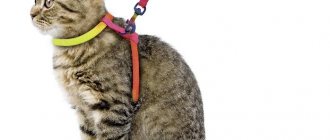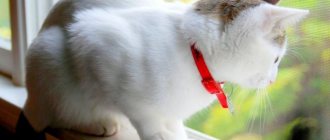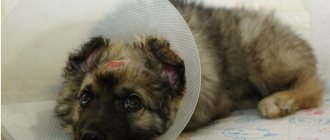A harness for cats is a very convenient device that is designed to accustom your beloved pet to walks. So if your furry pet is bored within the walls of a cramped apartment, it’s time to go outside. However, this is not as simple as it seems. For some cats, leaving the house is a real stress. In order not to injure your pet’s nervous system, you should accustom him to walks gradually. And you need to start by getting to know the ammunition. How to accustom a cat to a harness, how to make the right choice?
How to train a cat to wear a harness
Does a cat need to go for a walk?
There is an opinion that walking dogs is mandatory, but what about cats? Do they need to go outside from time to time?
Of course, it would be wrong to compare cats with dogs. Apart from the presence of four legs and a tail, animals have nothing else in common - neither character, nor habits, nor taste preferences. What about walks? Of course, if your cat has been sitting at home for several years, then it is likely that the prospect of going outside will not please her, even despite the fact that she spends all day on the windowsill and sighs languidly, watching the bird.
Preventing excess weight for spayed or neutered pets
Many veterinarians say that cats need to go outside to eat grass. It is known that it cleanses their stomach of unnecessary contents and allows them to normalize intestinal motility. In addition, green grass is a good source of vitamins and improves mood. Therefore, this is a strong argument in favor of walking.
Cat on a walk in a harness
He's not alone. Here's another. Everyone knows that every living creature on earth needs oxygen. A cat constantly sitting at home with the windows closed will obviously feel unwell. And this will manifest itself in weakness, reluctance to play and even eat. Therefore, owners who are against walking need to take utmost care to ensure that the pet receives enough oxygen. To do this, you need to regularly ventilate the room and open all the windows wide for half an hour at least several times a day. It's great if your apartment has a balcony. If you take the fluffy out on it at least several times a day, this will eliminate the need for walks.
Another important point: love for warmth. Surely, many owners have noticed that their pets are always near heat sources - a radiator, a stove. And some cats simply love to soak up the sun on the windowsill. And this is not because they need vitamin D, no, unlike humans, they can do just fine without it. They only need warmth, because without it, according to veterinarians, the cat may die.
Furry fidgets on the street may also like tempting rustling leaves, twigs moving quickly under the pressure of the wind, birds, butterflies, midges flying near their noses, and many other things that are attractive to cats.
Cat enjoying nature
However, everything is not so rosy. There are also several arguments that can convince cat owners to take them outside. This is a high probability of injury. This is often caused by motor vehicles. Despite the caution of cats, some of them, due to their timidity, still end up under wheels, receiving serious injuries. The same applies to meeting a dog, which, following its natural instincts, may unexpectedly attack a walking cat nearby.
Poisoning is another reason not to let your cat outside. Cats, by nature, are true hunters. Therefore, she will never refuse the opportunity to feast on a caught rat, mouse, bird or poisonous beetle. It is impossible to exclude the strange love of cats for garbage containers. Next to a tempting piece of meat there may be a chemical reagent that will penetrate the stomach and cause severe symptoms of intoxication in the form of nausea, vomiting, diarrhea and dehydration.
Cats are real hunters
No less dangerous are poisonous plants and exhaust gases, which also cause serious poisoning. All these troubles can be avoided if you accompany your cat on a walk, walk where it is clean, as quiet and safe as possible, and control his actions. And if you put a harness or leash on your pet, then she will definitely not be afraid of any danger.
Durable harness for walking
Which cats should not be walked, and who needs it?
The fact that fresh air has never harmed anyone is obvious. The oxygen received during walks saturates the brain and improves the functioning of all internal organs. And there is no need to talk about the benefits of physical activity for domestic couch potatoes. To make your cat's walk as safe as possible, you should follow the following rules:
- the cat must have all vaccinations;
- you need to take preventive measures in advance to protect your pet from fleas, ticks, and lice;
- Buy a harness or leash.
Walking is strictly prohibited for such cats.
- Kittens up to 5 months old, who, for either physical or psychological reasons, cannot conquer the outside world. In addition, at this age, many vaccinations that are simply necessary for safe walks are contraindicated. It is necessary to organize an exit to the street only after all the necessary injections have been completed.
- Pregnant pets.
- Weakened, sick cats, or those who have recently suffered from an illness and are not yet strong enough.
- Pets are very shy and afraid of noise and bright light.
- Overly aggressive cats (especially during heat). When they see another animal, they will always want to fight with it. And you don’t need this at all. The best option in this case is to walk where there are no other animals.
- Cats over 5 years old who have not previously gone outside.
Walks will be useful for hyperactive and courageous cats. You will definitely like the diversity of the surrounding world. And they are unlikely to deny themselves the pleasure of repeating this wonderful moment after some time.
If your cat managed to escape through an open window to nibble grass, don’t scold her for it. It’s better to organize joint walks.
Cat eats grass
It will be useful to shake up pets who used to be hyperactive, but have recently become lazy and began to spend most of their time on the couch. Perhaps the lack of oxygen is to blame. Try going out into the fresh air with him. This will help the pet shake itself up and, perhaps, return it to its previous lifestyle.
If your cat has long hair and it’s a hot summer, then an evening walk on the cool, lush grass won’t hurt him. Your pet will feel much better.
Important! Any cat can be trained to walk. The ideal time for this is childhood.
Protective equipment and choice of ammunition
In nature, pets face various troubles - infections, rabid animals, blood-sucking insects. Therefore, the cat must be protected from parasites - fleas and ticks. To do this you need to buy protective equipment:
- collar;
- drops;
- antiparasitic shampoos.
You will also need to get all the necessary vaccinations - on the street, your pet may encounter sick animals and become infected with various dangerous infections.
Choice of ammunition. After the cat’s body is ready to resist diseases and blood-sucking insects, it is necessary to buy walking equipment:
- Selecting an accessory . A cat needs a harness, not a collar. The cat's neck muscles are not strong enough, and any sudden movement can damage the cervical vertebrae. The harness should be strong, light, and safe. It should be easy to put on and adjust. The size of the harness should be such that 2 fingers can be inserted between it and the pet’s body. Then it will securely fix the animal, but will not press or rub.
- The optimal material option . The best material for cat gear is synthetic or cotton fiber. This “harness” is light, washes well and has no odor that might frighten a cat.
- The leash to the harness must be fastened securely so that the cat cannot break free and run away. For walking, a leash length of 1.5-2 m or a roulette leash for small breed dogs is sufficient.
How to get a cat accustomed to a harness
Buying a harness and putting it on your cat is only half the battle. This design will not immediately make a positive impression on the pet, but on the contrary, it will alert him. Therefore, you should not immediately attach a harness to his neck and drag him outside, not paying attention to the fact that the cat is dragging along the floor, screaming at the top of his lungs, his eyes bulging, and does not understand why he is being punished.
The most important thing in this matter is gradualism. Start with training at home, and only then try to take your pet outside. The first thing to do is place the structure next to the cat. Let her sniff it properly and touch it (but don’t play!). The cat must make sure that the item is completely safe.
First step to harness
Only after this try to put the harness on the animal. Don't drag the cat, don't drag it around the room. Let him lie down, walk around, run and understand that the strap does not pose any danger. Don't forget to praise, pet your pet, or give him his favorite treat.
Attention! Keep an eye on the animal. He may want to get rid of the harness, or crawl into some gap, get caught and get hurt.
The next day, proceed with more drastic methods. Put on a leash and try walking around the room with your cat. Just don’t drag her, let her take the first step herself. This may take time. It’s okay, you can wait, the street won’t go anywhere, and you’ll still have time to show off your new harness with rhinestones and your beautiful cat.
If your pet refuses to go, don't insist. Place your favorite treat near his nose. Surely he will rush after the prey. If this does not help, pick up the cat, move him 30 cm forward and give him a treat. Repeat the action several times. Feed the animal each time (give it a small piece, otherwise the cat will become completely lazy). If this does not encourage the cat to “communicate” with the leash, try playing with it.
Training a cat to wear a harness at home
Make sure that the cat understands that this thing is the best and safest in the world. When you remove the leash, ignore the cat. Once it's on your pet's neck, do your best to show him how much you love him. Over time, the cat will begin to associate putting on a harness and leash with something very good and kind.
Keep training every day. When your pet can move freely on a leash and in straps around the apartment, it’s time to go outside. If this is not the first time for your pet, then there probably won’t be any difficulties. It’s worse if the cat experiences the outside world for the first time.
Remember! The cat is frightened not by the street itself, but by the noise that is happening around, the bright light, the new environment.
If the fluffy one completely refuses to show his face from the entrance door, don’t be angry. Otherwise, all your work will go down the drain.
Cat's reaction to a walk in a harness
Caress your pet, give it some food, pet it. There should be no screaming, tugging, or kicking. Allow the cat to stay in the entrance for a while with the door open. Let her get used to the current situation.
Then go outside and call your pet. If the cat does not respond to your pleasantries, pick him up and gently hold him close to you. Attempts must be repeated daily. The pet will still, even if it takes a while, get used to the street. Every time you arrive, treat your cat with his favorite treat. When your pet finally deigns to go outside, he may jump into the grass or bush. Don't pull him out, let him sit, look around, sniff everything.
Cat's alertness while walking
After exploring the area, the cat will leave and follow in the direction that is of greatest interest. Do not pull the harness in the other direction. Always follow the cat, encourage it and praise it. If your pet begins to feel uncomfortable or afraid, for example, if a dog appears in the distance, pick him up and move him to a safer place.
Attention! Walk your cat, increasing the walking time by 5-10 minutes every day. Expand your boundaries.
The cat will feel more confident if you put his favorite toy in the grass in which he basks. You can feed the animal. Cats always consider the eating area to be safe.
Video - Accustoming a cat to a harness
Video - How to train a cat to wear a harness?
Who gets used to a leash easier?
Leash training can take quite a long time. You should be patient and not force things.
The younger the animal, the easier it gets used to the leash.
The kitten perceives training as a game and quickly gets used to the harness and leash. You should take into account not only the age, but also the breed of the cat. Cats with a “dog-like” character learn to walk on a leash more easily, for example:
- Maine Coon;
- munchkin;
- Abyssinian and Somali cats;
- Manx cat;
- American Curl;
- Turkish van;
- Devon Rex;
- oriental cat;
- Bengal cat;
- California speckled;
- savannah.
With the right amount of patience and approach, you can train any cat to use a leash. Training should be built taking into account the character and temperament of the pet and the training period should be divided into stages.
Useful tips and tricks
To ensure your training is successful, follow these rules.
- Never leave your cat on a leash unattended. Any noise or rustle can scare away the animal, and it will climb a tree. Wearing a harness can cause suffocation and injury.
- Do not pull the leash or drag the cat. This will cause damage and will forever discourage your pet from interacting with this item.
- Unfortunately, there are some cats that will never accept being kept on a leash. As soon as the structure is put on the neck, they fall like a stone to the floor and do not want to get up under any pretext. It is very difficult to fight such animals, and sometimes even impossible.
- Keep an eye on the dogs. Some of them can rush at a cat and cause serious injury to it. Therefore, if you notice a dog staring in your direction, pick up your pet, turn away and move to another place.
- Sometimes the harness is not the right size for the cat. If this is so, then the pet will not agree to go for a walk under any pretext. A suitable harness will help solve the problem.
- Don't loosen your grip on the leash. This will reduce the likelihood of the animal escaping.
- Carry a cloth bag or pillowcase with you so you can hide your cat from your dog.
Cat's reaction to a dog
A harness will help protect your cat from dangers such as poisoning, injury, or falling under the wheels of cars. Therefore, such a device should be in every home where there is a walking cat.
Article information
Featured Article
This article was co-authored by. Dr. Elliott, BVMS, MRCVS is a veterinarian with over 30 years of experience in veterinary surgery and the care of companion animals. She graduated from the University of Glasgow in 1987 with a degree in Veterinary Medicine and Surgery. He has been working at the same animal clinic in his hometown for over 20 years.
Category: Cat training
In other languages:
English: Leash Train a Cat, Português: Treinar um Gato para Andar na Coleira, Français: habituer un chat à la laisse, Español: entrenar a un gato a caminar con correa, Italiano: Addestrare un Gatto al Guinzaglio, Deutsch: Eine Katze an die Laufleine gewöhnen, Nederlands: Een kat leren aan de riem te lopen, Bahasa Indonesia: Melatih Kucing agar Terbiasa dengan Tali Kekang, ไทย: ฝึกใช้สายจูงกับแมว, 한국어: 고양이 리드줄 훈련하기, العربية: تدريب القطط على المشي بالطوق
This page has been viewed 21,758 times.
Was this article helpful?
Not really
How to choose a harness for a cat
If you definitely decide to go for a walk with your cat and accustom her to a leash, then the first thing you need to do is take care of choosing the right design.
Remember! Veterinarians do not recommend walking a furry pet wearing a collar. These structures can injure the animal’s delicate neck. With the help of a harness, the load on the spine is distributed evenly. In addition, the cat is unlikely to break out of this convenient device, but it can calmly escape from the collar, especially if it is very frightened.
The design should not fit the animal’s body too tightly. Place two fingers under the loop. Do they fit in? Perfect! With these parameters, the animal will not feel discomfort and will be able to swallow saliva freely. Therefore, before purchasing ammunition, take care of the necessary measurements - neck and chest circumference. Show them at the pet store and choose a harness that is suitable for your pet.
Perfectly shrunken harness
Many harnesses sold are adjustable, allowing you to adjust the size. Accordingly, the prices for such devices will be higher.
Important! When the animal is in a harness, try not to scold it. Otherwise, she will associate the object with fear and discomfort.
The material used in manufacturing is also important. You should also pay attention to this nuance when purchasing a harness. Typically, for kittens, the design is made from soft and elastic materials that stretch well. These are not suitable for adult cats - only made from nylon and other denser materials.
In addition to the harness, you should definitely purchase a leash. In this case, its length matters. If your pet is shy and always stays close to you, then preference should be given to short, fixed-length leashes.
For more active, inquisitive and hyperactive pets, roulette leashes or stretchable accordion leashes are suitable. The prohibition against purchasing such devices is the small size of the cat. They are not able to pull a long leash with full strength.
Roulette leash
It is important to consider the quality of the harness material. Even with the slightest electrification, a cat may feel discomfort and refuse to walk in a harness forever.
Leash “Stretchable accordion”
When choosing a design, you should focus on the quality of the parts. For the convenience of the cat, it is better not to purchase products that are connected with glue or rivets. A good quality harness should be stitched. Then the risk that the pet will run away is very small. The fasteners should snap well and not come apart when the leash is pulled.
Kinds
Harnesses are usually sold complete with a leash. They consist of two collars, one of which is fixed on the cat’s neck, and the second on the stomach.
Therefore, when choosing a particular model, it is very important to pay attention to the parameters of the animal and buy a harness that is not too small or large. The leash is attached to the harness using a special ring. Its maximum length can reach 2.5 m; there are also models 4 meters long
Its maximum length can reach 2.5 m; there are also models 4 meters long.
Today you can find a huge assortment of cat harnesses on sale, which differ in the material they are made of. Most often, this accessory is made of thick fabric and tarpaulin, but it is best when the harness is leather. In addition, products can differ in color and decorative options; models decorated with stripes and rhinestones are very popular. To participate in exhibitions, pet owners, as a rule, purchase original harnesses. For ordinary walks, you can give preference to cheaper options.
The most common types of harnesses include the following.
Harnesses-overalls. They are considered universal because they allow you to additionally protect your cat from cold and pollution. On the back of the accessory there is a ring with which you can attach a leash. Thanks to the chic selection of colors and designs, harnesses and overalls can be easily selected to suit every taste.
The connection point of the loops is on the back (between the shoulder blades), and a ring is fixed to it for connecting the leash. The loops have convenient adjustment, which is carried out using special fasteners. This allows you to adjust the size of the harness to the specific dimensions of the cat.
Leashes-collars in the shape of the letter V are also available for sale. They are similar to regular harnesses, the only thing is that the straps are connected to each other under the chest.
Types of harnesses
Essentially, a harness is a structure that consists of several straps that cover the cat’s torso in the area of the shoulder blades. It is usually fastened on the back of the cat. This counters the stress placed on the animal's neck. The leash is attached to a ring attached to the harness.
The variety of harnesses for cats is huge. They can be different in size, shape, method of fastening, made of different materials, etc.
Table 1. Types of harnesses for cats.
| Name | What is | pros |
| Figure-of-eight harness | Made in the form of two loops attached behind the front legs and on the neck | Does not allow the cat to break free and escape. The pet can move calmly. His movements are not constrained |
| V-harness | Similar to the previous design. The difference is that on the chest area the straps are attached in the form of the letter V | The cat won't be able to escape. The design does not put any strain on the animal's neck. Does not hinder movement |
| H-shaped harness | The design is also similar to the previous ones. It differs in the shape of the loop. It is represented in the form of the letter H | The pet will not run away from the owner. There is no pressure on the pet's neck. The animal can move freely |
| Vest | Presented in the form of a jacket, which is worn on the front of the animal’s body. The fastening can be with Velcro or buttons | Will not allow the animal to escape from the owner. Protects the cat from pollution. In addition, it provides her with warmth in winter. Does not squeeze your pet's neck. Movements are carried out calmly |
Important! Veterinarians recommend purchasing a harness that consists of straps.
The fabric of the harness should not be rough or hard. It is better to choose an elastic material that can stretch. Nylon or cotton is ideal for this. Such harnesses do not cause discomfort to the cat. It is better not to purchase a device made of leather. It is quite hard and heavy, which can be painful and unpleasant for the pet. Width also matters. The belts should be more or less wide. Ideal parameters are 1-1.5 cm.
Why does a cat need a collar, leash or harness?
Even the most phlegmatic domestic cats are happy with the new experiences that a walk gives. And if your pet has an active temperament or has lived on the street in the past, he may feel sad, sitting in the apartment all day long. In order to make walking with your cat safe and comfortable, special devices come to the rescue: a collar, a leash and a harness.
Walks give cats many new experiences
Collar
Some owners purchase anti-parasitic collars for their cats, which the pets even wear around the house. But for a walk you need a more reliable collar with a strong clasp.
If your cat walks, as the saying goes, on its own, you need to choose a comfortable collar for it that will not allow the animal to get caught on protruding dangerous objects and will not fly off during active movements. In addition, the collar must have a mount for an address book on which you can write the cat’s name, your phone number or address. If the pet gets lost or gets into trouble, the people who find it will be able to return the poor thing home. When deciding to walk an animal on its own, you need to be aware that it is unsafe.
The pet's collar must have a tag with the owner's number on it.
An option in which you can not worry about your pet, but at the same time give him the joy of a walk, is to use a collar in tandem with a leash.
Leash
As mentioned above, a leash is the key to a safe walk with a cat. It is best to opt for a long but strong leash. A chain, unlike dogs, is not suitable for cats - it is heavy and can scare your furry or cause him pain.
The cat's leash should be soft and light
And, of course, even when walking on a leash, put a tag with contacts on your cat’s collar - just in case.
Harness
What should you do if your mustachioed pet refuses to walk on a leash and doesn’t like the collar? It doesn’t matter, you can replace these devices with a harness. It looks like an interweaving of wide straps that cover the chest, part of the back and paws.
As a rule, this object irritates cats less and causes less pain when moving, because the throat is a sensitive part of the body of any living creature. When wearing a harness, most of the load falls on the chest, not the neck. And in case of danger (an approaching dog, falling into a hole), it is much easier to grab the pet by the back strap of the harness than to pull the leash.
Most cats enjoy being walked on a harness rather than on a leash.
Why does a cat absolutely not want to come into contact with a harness?
Pets, even after long training, do not always agree to contact the harness. Perhaps during the training process you did something wrong - you treated the cat roughly when putting it on, or you shouted at the animal when it categorically refused to put its paw into the hole, or you pulled the leash too hard, not allowing your pet to move freely around the apartment. All these actions can forever discourage your pet from not only going for a walk, but even looking at the hated harness.
Cats do not always agree to be in contact with a harness.
What else can provoke a cat’s reluctance to wear it?
- As you know, cats, by nature, are true clean people. They spend all day licking their fur until it shines. When something interferes with this, the animal begins to fuss and get nervous. So is the case with the harness. In addition, the cat may be worried about the condition of its coat.
- If the cat, after putting on the harness, begins to actively bite it and tries to remove the structure with its hind paws, it may be due to the wrong size. Maybe the straps are constricting her body, rubbing her, restricting her movements. As already mentioned, the distance between the strap and the body of the animal should be 2 cm.
- A cat may refuse to wear a harness because it is frightened. If there are various bells, decorations and other “things” that irritate the animal, then it is unlikely that he will want to put on the ammunition next time.
Attention! If every time you go outside, your pet meows as loud as he can, does not want to leave your hands, and when you try to put him on the ground, he climbs over you like a tree, then, unfortunately, your pet is not made for walking. It's best to leave this idea. Surely, your cat is a real homebody and a window sill is the ultimate dream.
Cat's reaction to a walk
Step-by-step training for an adult cat
Step-by-step training takes into account the psychological characteristics of the cat.
Remember, when training an adult cat, it is important to act gradually, since the animal must develop exclusively positive emotions regarding equipment and walks with the owner
Training needs to start at home
You can start immediately after the cat has gotten used to the new accessory and has stopped paying attention to it.
Step #1: Start putting a harness on your cat at home for short periods of time, but every day. Starting with a period of 1-5 minutes, increase the time your cat is in the harness to 20 minutes.
Typically, it takes 3-5 days for adult cats to become fully accustomed. While the cat is wearing a harness, distract it in every possible way, treat it with treats and praise. Try not to touch the harness until your cat is completely used to it. The adaptation period can be considered over if your cat calmly moves around the house, washes in it and eats food in a harness.
Step No. 2. Leash training. Attach the leash carabiner, but do not exert any influence on the cat. Make sure that the leash is not pulled tight and follow your pet everywhere. When the cat gets used to the accessory, you need to teach it to move next to you.
Every time you influence the cat's movement, attract the cat's attention with a treat: pull the leash towards you a little, show the cat the treat and wait until it comes. Tip: Train your cat to ask to be held when she is afraid or nervous
To develop a habit, it is enough to pick up your pet when he seems to be showing signs of uncertainty.
Tip: Train your cat to ask to be held when she is afraid or worried. To develop a habit, it is enough to pick up your pet when he seems to be showing signs of uncertainty.
Step No. 3. Go outside. Under no circumstances should you force your cat to go outside until she decides to take this step herself. Most pets, even curious ones, are afraid to leave their safe territory.
You can set an example for your pet by going outside and calling him to you. If the cat is afraid and ignores your call, do not insist. If your pet completely trusts you, you can try to carry him outside in your arms.
Repeat attempts to go outside every day until your ward decides to cross the threshold.
Once you are successful, reward your cat generously with praise and treats. Under no circumstances should you pull on the leash if your pet decides to go for a walk. Constantly follow the cat and encourage it. As soon as your pet starts to worry, pick him up and bring him home. Refrain from your walk or reschedule it if you notice dogs on the street! At the beginning of training, the pet feels very vulnerable and can be very scared.
Step #4: Maintain consistency. Once you have achieved success, start walking your pet every day. Gradually increase your walking time to 20–25 minutes. If the cat is worried, pick it up, calm it down and distract it with treats. Perhaps the pet will feel more confident. If you put familiar toys on the ground.
As you increase your walking time, begin to increase the distance your pet walks. Make sure that you always remain in the field of view of the ward, so he will feel safe.
Constantly offer your cat treats; four-legged cats instinctively consider the eating area safe. As soon as the pet begins to confidently run up for a treat, we can assume that he is accustomed to walks.
Where should you walk so as not to scare the cat?
It is preferable to start from a balcony or loggia. At first, hold the cat in your arms and show him all the delights of nature from above. Let him get used to the sounds of cars, the barking of dogs, the chirping of birds. This is a very useful activity. When you go outside for the first time, these sounds will no longer seem unfamiliar to the kitty.
Cat on the balcony
What are the best places to go for a walk?
- The walk should be carried out as far as possible from highways and roads with loudly roaring cars. It is unlikely that in such an environment the cat will want to walk and enjoy nature. Silence is the key to a good walk. And the exhaust gases emanating from vehicles are harmful to the health of the pet (and the owner too).
- It is preferable to walk in places where there are no dogs. A huge barking dog can greatly frighten a cat, and there is no need to talk about the possibility of an attack. So be careful. If you see a dog nearby, it is better to quickly pick up the cat, turn away and go to another place.
- No need to walk near trash cans. Despite the fact that the cat will be wearing a harness, this cannot always 100% protect him from the opportunity to grab a tasty morsel lying next to the trash heap.
- Areas with tall trees should also be on the list of places where cats should not be walked. A frightened pet can escape and climb high, high. And no amount of treats, toys, or kind words will pull him away from there.
The cat climbed a tree
Walking outside
It is important to understand that you can only walk on a leash outdoors when the cat itself shows interest and comes down to the ground. Before the animal shows interest in the outside world, we carry the pet in our arms and sit it on the ground in tall grass. The cat should feel your palms in any conditions and be able to hide.
Choose a quiet area with tall grass for your walk. After letting the cat get used to it, sit next to it on the ground and wait. Do not pull the leash, provoking the animal to walk, even if the cat lies in the grass for 20–30 minutes - she is walking, accept it. Watch carefully so as not to miss the first steps of your ward. Most likely, the cat will move in short jerks, clinging to the ground - this is normal.
We remember how we followed the cat at home and repeat the same manipulations on the street. Don’t forget to talk to the animal; the cat will most likely refuse treats. Don't be surprised if the walking route follows a straight line, with the cat running forward and returning - this is an exploration tactic used by many wild animals and birds. It is important for a pet to understand that during a walk he is protected by the owner; take the pupil in your arms and stroke him more often. Show a little more patience, after 5-7 days, “your hero” will confidently walk down the street on a leash.
Popular harness models
The market offers quite a lot of models of harnesses for cats. Having studied the offers of some online stores and analyzed the quality characteristics of various products, we offer our rating of cat harnesses.
Table 2. Comparative characteristics of cat harness models.
| Name | Characteristics | Dimensions | Advantages | Flaws |
| Model from TRIXIE | Harness with stripes that reflect light. The set includes a leash, which is attached to the harness with a durable metal carabiner | Strap width – 1 cm. Chest circumference – 22×42 cm |
| Flashing stripes can frighten an animal |
| Model from ReflectoCat S Rogz | Made from polyester. The set includes a leash, the length of which is 1 m 80 cm. The fasteners are made of acetate plastic. They are very strong. When opened, the animal's fur does not come off and is not damaged. The carabiner connecting the leash to the harness opens with significant tension. This allows you to unfasten it when the animal climbs a high fence and tree. The product is bright, beautiful, the set includes bells | Strap width – 1.1 cm. Size – S |
|
|
| Model from DEZZIE, created for kittens | Nylon based material. The set includes a leash 1 meter 20 cm long | The width of the straps is 0.8 cm. The chest circumference is 21x34 cm. |
| |
| Model Hunter Smart from Strips | Made from nylon. The kit includes a leash 120 cm long. The dimensions are adjusted using plastic sliders on the slots | Strap width – 0.8 cm. Chest circumference – 22×46 cm, neck circumference – 22×33 cm |
| Narrow straps |
| Trixie model for kittens and small cats | Made of artificial leather. The set includes a leash 1.2 m long | Strap width 0.8 cm. Bust circumference – 22×32 cm, neck circumference – 22×28 cm |
| You will have to buy a new harness when the animal grows up |
The basic rule for walking furry pets is that the cat is not the owner. The cat must walk the owner. Therefore, do not pull the leash or drag the animal in the opposite direction. If this place is dangerous, just pick him up and take him to another place. You should not prohibit your pet from exploring the territory.











